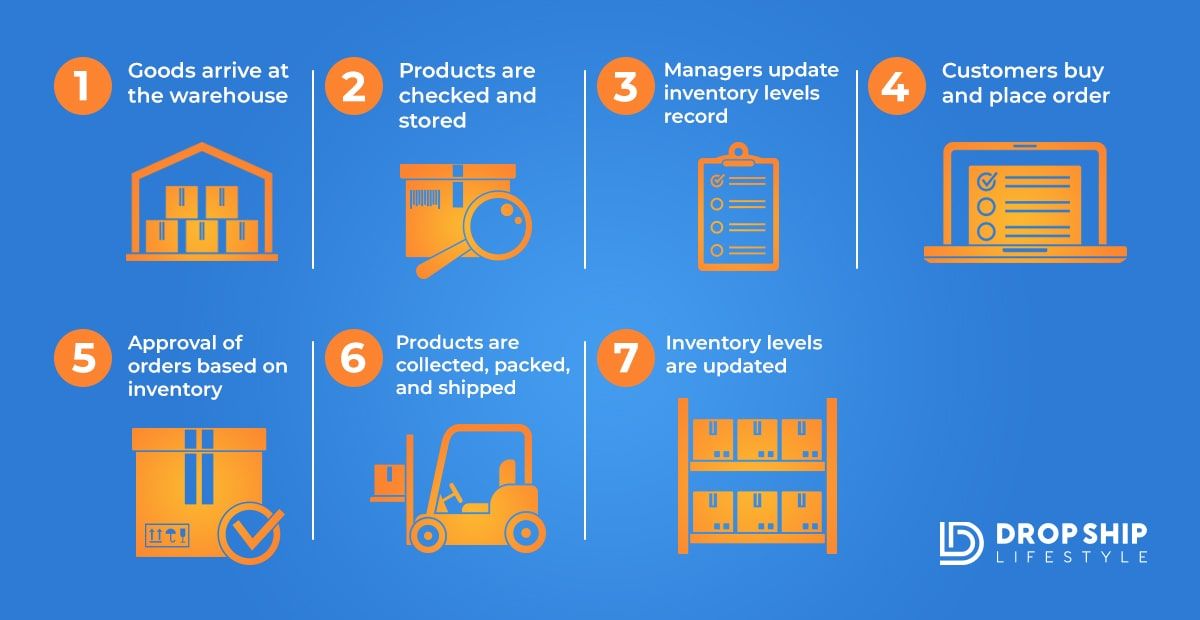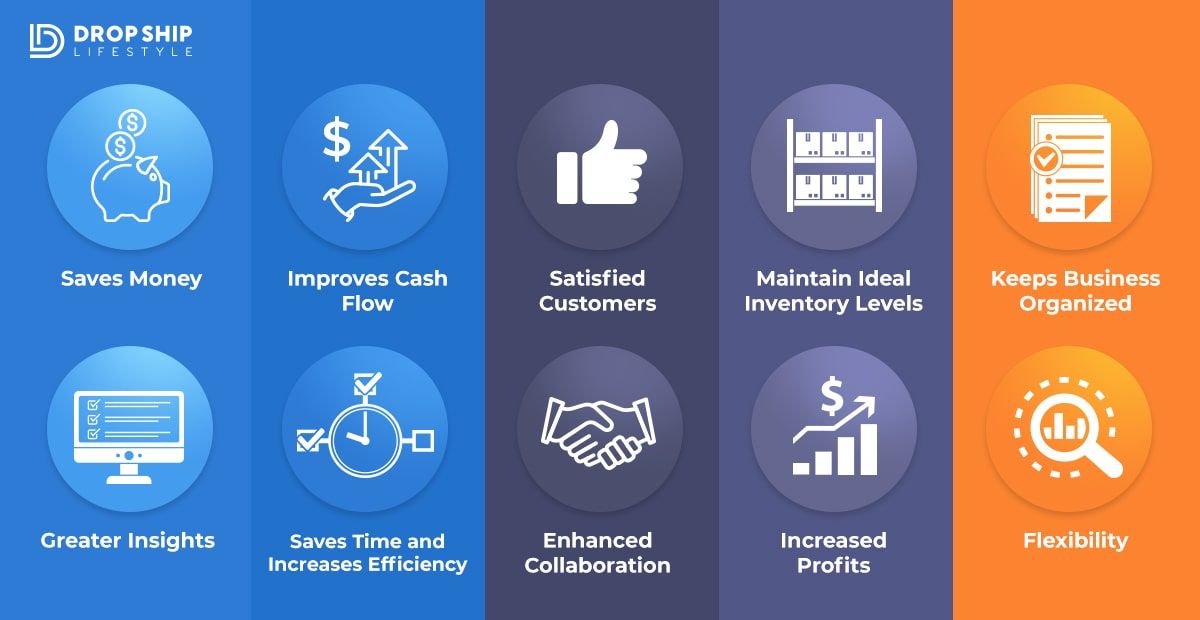Inventory management is an integral part of a business’ profitability. If a company doesn’t practice good management, especially with their items that sell very well, they’ll lose more than they earn. If there’s too much inventory, it will bleed into the company’s money. And if there’s not enough, customers can be lost.
To help you better understand what inventory management is, we created this article about its benefits, challenges, and how you can do it for your Shopify store.
What is Inventory Management?
Inventory management is the supervision of the flow of inventory. This includes the ordering, storage, processing, and selling procedures. It’s the management of goods like raw materials, components, and finished products. This means you track the inventory starting from the manufacturer, warehouses, and to the point of purchase.
At the same time, there’s a detailed record kept for every product or item as it enters or leaves a facility. Its main goal is to ensure that the right products are in the right place at the right time. Visibility is required for this to ensure when to order, how much to order, and where to store the goods.
Here’s a basic example of an inventory management system:

- 1Goods arrive at the warehouse.
- 2Products are checked and stored.
- 3Managers update inventory levels record.
- 4Customers buy and place orders.
- 5Approval of orders based on inventory.
- 6Products are collected, packed, and shipped.
- 7Inventory levels are updated.
Inventory Management vs Inventory Control
There are many steps involved in managing inventory. Steps like managing the stock and all daily activities involved. This is where inventory management and inventory control come in. Although both are essential for successful sales and operations, there are differences.
Again, inventory management ensures that a business always has the right amount of inventory. It collects data and analyzes it for decision-making processes. It’s performed to help forecast and reorder goods. For good inventory management in a business, there should be good inventory control as well. Here are some of its main functions:
Inventory control is the management of inventory within its storage location. It’s also called stock control because it’s regulation of the stocks of products in a warehouse. It ensures that all goods are in usable condition and there is no stockout or overstocking. Here are some of its main functions:
Inventory control is a smaller process and is part of the whole inventory management process. For a clearer distinction, here’s how the two are different from each other:
Benefits of Inventory Management

Here are more benefits of inventory management:
Saves Money
This is the most important advantage because inventory is a business’ most important asset. It’s expensive and is only profitable until it sells. If a company can’t sell its inventory, it eats the costs of inventory, storage, and handling.
Surplus or too much inventory can result in risks of storage costs, spoilage, theft, and damage. With inventory management, companies can avoid these risks so they can order just enough to meet demands and save money.
With the saved money, you’ll have money to spend elsewhere, like payroll, new equipment, or new product development.
Improves Cash Flow
With proper inventory management, you only spend money on products that sell. There is no overstocking that impedes cash flow due to unnecessary costs and expenses without return profit. Since you can ensure accurate inventory orders and if there is the right amount of inventory, you spend only on profitable inventory that generates more cash flow for the company.
Satisfied Customers
One important benefit and result of inventory management is it helps improve customer experience. Shortage of inventory when and where it’s needed can result in unhappy customers. Customers expect companies to have items to be always in stock, and when they don’t, customers would rather purchase from someone else than wait for new stock.
If you fail to fulfill their demands, you lose business and hurt your company’s reputation. If it constantly happens, it will eventually result in an unprofitable business. But with inventory management, companies can keep a detailed record of their customer’s demands and make informed ordering decisions. With enough inventory, customers will always be satisfied and happy.
Maintain Ideal Inventory Levels
When companies know how to manage inventory, they can ensure a balance between their inputs and outputs. This balance is vital to a company’s profitability and health because overstocking can eat the company’s resources and money spent, while stock-outs can disappoint customers.
With proper inventory management, these levels can be maintained and avoid potentially harmful consequences.
Keeps Business Organized
Poor warehouse management makes a company inefficient and puts time and money to waste, which can all ultimately hurt the business. Inventory management helps in organizing storage locations since you can track inventory and supply chain movement with it.
Additionally, by organizing products and operations, the whole order fulfillment process can be sped up and mistakes can be avoided while keeping customers happy at the same time.
Greater Insights
With proper inventory tracking and stock control, it would be easy to spot any sales trend and track expiration dates or recalled products. With this information, you can adjust your inventory and operations to ensure efficiency.
Saves Time and Increases Efficiency
Inventory management often involves the use of specialized software and hardware. Businesses make use of devices, like barcode scanners and smartphones, and data storage and analysis systems to make every inventory operation efficient. These tools help automate tasks that speed up the management and operations, like recounting stocks and checking for records. At the same time, employees will be able to focus on more important tasks since there's a reduction in the time required to perform mundane tasks.
Enhanced Collaboration
The sales department can easily switch with the warehouse and check if a specific product is in stock with good inventory management. This results in good cooperation between the two and ensures that processes are optimized.
Increased Profits
Since you’d be able to avoid deadstocks and overstocks, you can avoid revenue loss and make cost-saving decisions with the accurate data you can get from an inventory management system. Wasting funds will be avoided with all that data. You can also remove stock expenses from human errors and make better choices for your profit margins.
Flexibility
Everything is unpredictable after COVID-19 so being able to make sudden changes to fix sudden problems is a good benefit you can get from a good inventory management system. With increased visibility, you can easily make decisions to accommodate certain issues and trends as they occur.
How to Manage Inventory In Your Shopify Store
There are two different ways how to manage inventory on your Shopify store:
Free Method
This is the manual method of updating the inventory section of your Shopify product pages. Basically, what you’ll do is go to a product’s page and edit the product variant. In there, you’ll have to check the inventory settings of the product and make sure the quantity is tracked so you can edit how many available stocks you have left.
It’s an effective way to manage inventory online but it can take a lot of time, especially if you’re selling many different SKUs from a ton of different suppliers.
Paid Method
This method uses a Shopify app to manage and update inventory. I recommend the app called Stock Synch, which you can find in the Shopify App Store. It’s affordable and free, depending on how you want to use it.
This app connects to both your Shopify store and your supplier’s inventory in many ways. You can simply edit a CSV file regarding the inventory and quantity and upload it with the app to the backend of your store and all the inventory of SKUs in the CSV file will be updated. This is a huge time saver, especially if you find it hard to manually track your out-of-stock products.
Challenges of Inventory Management
Managing inventory is a challenging task since a slight mistake and mismanagement can impact every aspect of a business. There are many challenges in doing it which one should be careful about.
Primary challenges include having too many stocks and not being able to sell them, not having enough stocks to fulfill orders and having a poor understanding of existing or available stocks and their location. These are very common, especially for big companies with multiple warehouses or storage locations.
For a better understanding, here are more common challenges to watch out for so you can manage inventory better:
Wrap-Up - Taking Control of Your Inventory
Inventory management is an essential system and process for any business that sells products. With it, you can ensure that there are enough stocks for your products to meet your customers’ demands without incurring any monetary losses. You can track your inventory and see how your business is doing. Are you selling your products or not?
If you’re running a Shopify store, you should know these basics about inventory management so you have an idea of how to ensure you’re selling profitably. Again, there are two ways you can manage inventory online for your store, the free and paid methods, so you can choose which one would work best for you.



Hey Everyone,
As many of you already know I created Drop Ship Lifestyle after selling a network of eCommerce stores and then trying to find a community of other store owners to network with… What I found was a bunch of scammers who promised newbies they would get rich quick by following their push-button systems!
This led me to create a new community along with an online training program that shares how to build a REAL online business.
I’d love to hear what you think… it’s a 2.5-hour training designed to help you drop ship profitably… all for free.
Be sure to click here to check it out and send me your feedback!
If you go through the “How To Start & Grow A Hyper-Profitable Online Store” webinar and still have questions just contact me and I will help you out